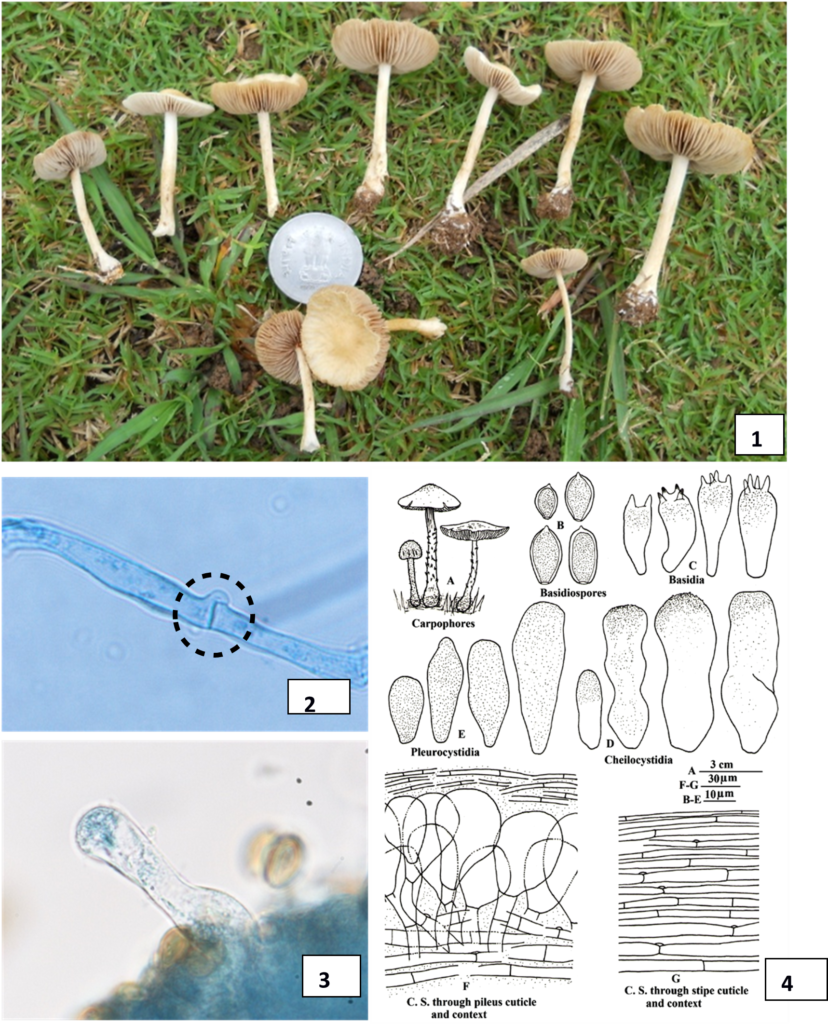Agrocybe splendida Clémençon
MycoBank number: MB 308403; Index Fungorum Number: IF 308403; Facesoffungi number: FoF 10429;
Agrocybe splendida Clémençon, Nova Hedwigia, 28 (1): 8, 1977.
Synonyms
Agaricus pusillus Schaeff., Fungorum qui in Bavaria et Palatinatu circa Ratisbonam nascuntur Icones, 4: 45, t. 203, 1774.
Agaricus semiorbicularis Bull., Herbier de la France, 9: t. 422:1, 1789.
Agaricus pediades Fr., Systema Mycologicum, 1: 290, 1821.
Agaricus arenicola Berk., London Journal of Botany, 2: 511 [‘411’], 1843.
Naucoria pediades var. obscuripes Fayod: 226, 1889.
Naucoria arenaria Peck, Bulletin of the New York State Museum, 157: 29, 1912.
Naucoria subpediades Murrill, Lloydia, 5: 150, 1942.
Description
Humicolous, growing scattered on humicolous soil among grasses along roadside Sexual state: Carpophores 3.2–6 cm in height. Pileus 1.2–3.4 cm broad, dome like when young, applanate at maturity; broadly umbonate; surface moist; yellowish white (4A2) to greyish orange (5B3) with light yellow (4A4) to pale orange (5A3) centre; rough and wrinkled; scaly, scales powdery, washed out at maturity; margin regular, splitting at maturity; cuticle fully peeling; flesh 0.2–0.3 cm thick; offwhite to light yellow, unchanging; taste sour; odour spicy. Pileal veil absent. Lamellae adnexed to sinuate, notched; unequal, in 4 lengths; lamellulae present; trabeculate; distant; moderately broad (0.4 cm broad); white (4A1) when young, greyish yellow (4B4) in mature, unchanging; gill edges white, serrate; normal. Spore print brown (6E4). Stipe central, 3–5.7 cm long, 0.1–0.5 cm broad, equal in diameter with distinctly bulbous base covered with white mycelium; pale yellow (4A3), unchanging; solid when young, hollow at maturity; scaly, scales white, fibrillose, scattered all over the stipe, longitudinally striate; exannulate. Basidiospores 10.74–16.9 × 7.6–8.45 (10.14) µm (excluding apiculus), (Q=1.6) elongate, lentiform; smooth, double walled; golden orange, slightly granular; truncated with an apical germ pore; apiculate, apiculus 0.84–1.69 µm long, prominent. Basidia 20.28–28.64 × 8.95–11.83 µm, clavate, upper part granular, –2,–4 spored; sterigmata 2.53–5.07 µm long, granular in few basidia. Pleurocystidia 20.28–46.54 × 7.16–17.9 µm, claviform to lageniform, fully granular, few with constricted apices, abundant. Cheilocystidia 23.66–48.33 × 7.16–18.59 µm, lageniform, few pedicellated, fully granular, encrustations in and on upper part, few hyaline; gill edges heteromorphous sometimes sterile. Carpophore context homoiomerous. Pileus cuticle cellular, made up of pyriform to spherical, hyaline elements, individual elements measuring 11.82–30.42 × 13.52–23.64 µm, covered with gelatinous layer of broken hyphae; pileus context hyphal, made up of hyphal network mixed with cellular elements. Hymenophoral trama regular. Stipe cuticle hyphal, made up of longitudinally, parallely arranged, 3.94–11.82 µm broad, septate hyphae. Clamp connections present throughout. Asexual state: not observed, but see notes.
Material examined: INDIA, growing scattered on humicolous soil among grasses along roadside, 23 July 2009, Harwinder Kaur, PUN 5926.
Distribution: Europe, growing solitary to gregariously, in parks, gardens and in lawns during summer to fall.
Notes: The gross external and internal details of the presently worked out collections match well with the details given for Agrocybe splendida Clémençon by Breitenbach and Kränzlin (1995). They cited Clémençon (1976) and commented that some fruiting bodies of this species have many pleurocystidia while the others are with a few pleurocystidia, in the presently examined collection the pleurocystidia are abundant. The collections were also compared with another allied species A. arenaria (Peck) Singer, but the abundance of pleurocystidia in the present collections puts them under A. splendida as in A. arenaria the pleurocystidia are very rare. A. splendida constitutes a first time report from India. Consumption Habit: Edibility unknown.

Fig. 1– 4 Agrocybe splendida Clémençon: 1 Carpophores showing undersurface of cap and distinctly bulbous stipe 2 Clamp-connection in pileus cuticle 3 Gill edge showing Cheilocystidia. 4 Camera Lucida drawings (A Carpophores. B Basidiospores. C Basidia. D Cheilocystidia. E Pleurocystidia. F C. S. through pileus cuticle & context. G C. S. through stipe cuticle & context).
